
A lovely pairing of the delicate naturally sweet crab meat with the also sweet and tender long purple eggplants in a deliciously rich modern Asian style sauce, garnished with a firework of curled spring onions, and served with a wedge of lemon. From the photo, it’s easy to see why orange is the colour that stimulates appetite and the colour of choice for many food businesses. The gleaming vibrant saffron orange of the mud crab shell is deliciously enticing and inviting – nom.
[dropcap]Inspired[/dropcap] by our chance encounter with an ultra tiny pea crab in one of the mussels we prepared last week; this week, I decided to cook a crab of a more substantial size – a mud crab, aka ‘mangrove crab’ or ‘muddie/muddy’ – in a mildy spicy stir-fry sauce, paired with the sweet flavour and tender texture of long oriental eggplants.
There are two types of mud crabs available in Australia – Giant Mud Crab (Scylla serrata) and Orange Mud Crab (Scylla olivacea). We obtained our crab from the local fish market, and although the fishmonger said that it’s from northern Queensland – I’m not sure what species it is exactly. My guess is that it’s a Giant Mud Crab because they’re far more common in Australia than the Orange Mud Crab.((1)) Either way, I don’t like to judge a book by its cover, and beyond the acute snappy fierceness of these heavily armoured beasts, I see their inner sweet, meat tenderness.
The moniker of ‘mangrove crab’ indicates where they dwell – providing an opportunity for all adventure-spirited folks to express their inner hunter/huntress and try to trap/catch these prized delicacies. Many estuaries and backwaters of Sydney are perfect spots to set traps for these side-walking creatures, and we live to tell the tale of having successfully trapped/caught several fine, meaty specimens in the Hawkesbury River. Although, please be careful if you’re going to try this, because it can be dangerous (but fun, nonetheless).
We purchased our mud crab early yesterday (Friday) arvo, and the fishmonger asked if I was going to cook it last night. I said ‘yes’ without thinking and so he kindly packed the crab in a Styrofoam box with crushed ice to keep it fresh and send it to sleep. When we arrived home, it was already dark, and having fallen victim to the art of food blogging/food photography (whereby meal making is determined by the time and weather of the day to ensure the best possible photo/lighting opportunity [can you believe it?]), I decided to hold off cooking the mud crab until today.((2))
The original recipe for this crab stir-fry is simply to cook the crab by itself with the other mandatory stir-fry ingredients. This time around, I wanted to give it a twist and decided to add another key component that would pair and complement the naturally sweet flavours of the crab meat. After browsing the fruit and veg market, I finally settled on some lovely long thin purple eggplants, which was not labelled but the check-out lady passed them through as ‘baby eggplant’.((3))
Of course, you can use the common, more bulbous/voluptuous eggplants, but the long thin variety are evidently sweeter, less bitter and more tender to eat. The small round Thai/kermit eggplants are very tasty too (raw or cooked) and would also play a great contribution to this dish. The eggplant world is quite incredible really, and it fascinates me.
I enjoy eggplants in all of its incarnations and the pairing of the long thin eggplants with the mud crab in this stir-fry turned out a lot better than I had anticipated. The mud crab still maintains its hero role, and the eggplant plays a subtle yet deliciously sweet supporting element, melding in with the sauce and other ingredients quite harmoniously – think ‘crouching crab, hidden eggplant’. The soft, silky flesh and slightly slippery and squeaky skin of the eggplant also provide a lovely textural character to the dish and lifts this stir-fried mud crab experience to another level.
Please give this recipe a try. Be sure to cook the mud crab asap, after you’ve put it to sleep in the freezer. If you can’t source mud crab, you can swap it for other types of crabs, such as blue swimmer or spanner crab, or one of your local crabbies. Perhaps, you might want to substitute it for other crustaceans, such as marron, Balmain bug, lobster, etc. And if you have trouble finding the sweet long ‘oriental’ eggplants, don’t fret – I’m pretty certain the popular/common variety will work just fine. Enjoy your meal! smile
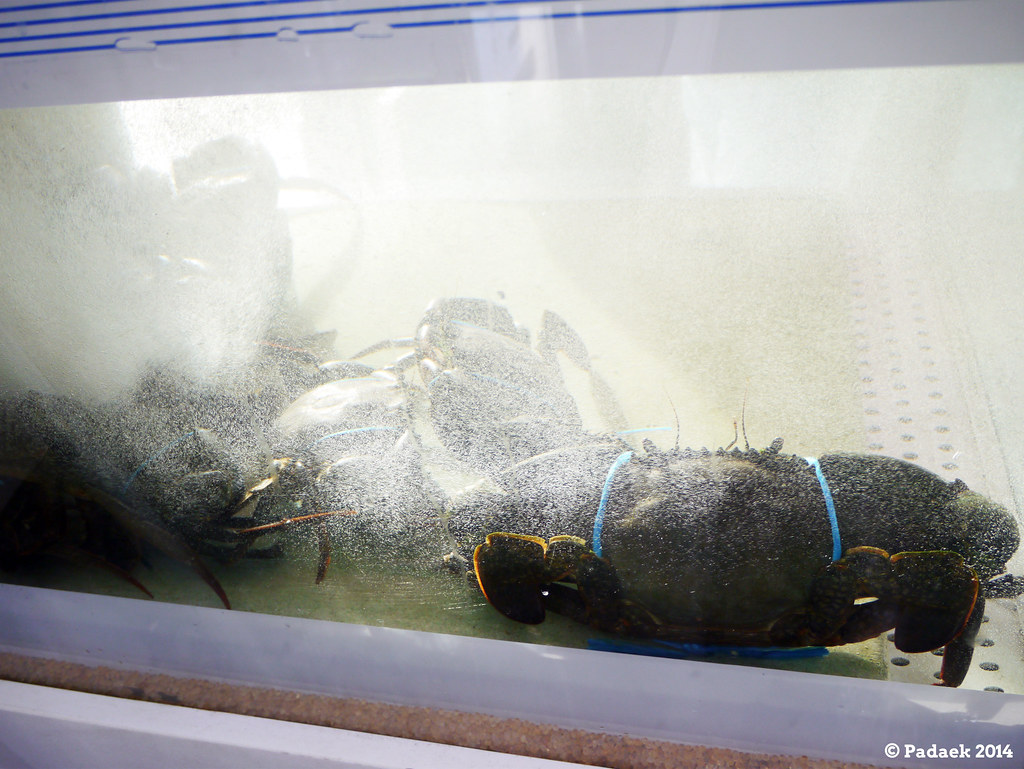

Place the crab in the freezer (or a box of ice) for about 1 hour to put it to sleep.

Note: Curled spring onions are an awesome garnish to add to any Asian seafood dish (steamed fish, steamed oysters, etc (or any dish for that matter). Instead of using plainly sliced or chopped spring onions, curled spring onions provide a pretty visual appeal for special dishes or occasions. Making them is totally easy too – all you need to do is wash and cut the root off the spring onion, cut the stem and leaves into about 5 cm pieces (or longer) and then with a sharp knife, slice each segment into very thin slivers. Then, simply place the thinly sliced pieces into a bowl of cold water with ice cubes. Magically, the spring onion strips will start to curl up. You can quicken the process by placing the bowl in the fridge. The process should take about 1 hour, maybe longer, depending on how curly you want them to be and how icy cold the water is, etc. I used one large spring onion to make the curled garnish for this dish, and there was plenty remaining. It’s a tedious, time-consuming process but I think it’s well worth the effort because they look so cool and give a dish that x-factor element. Be careful of your fingers when slicing the spring onions!
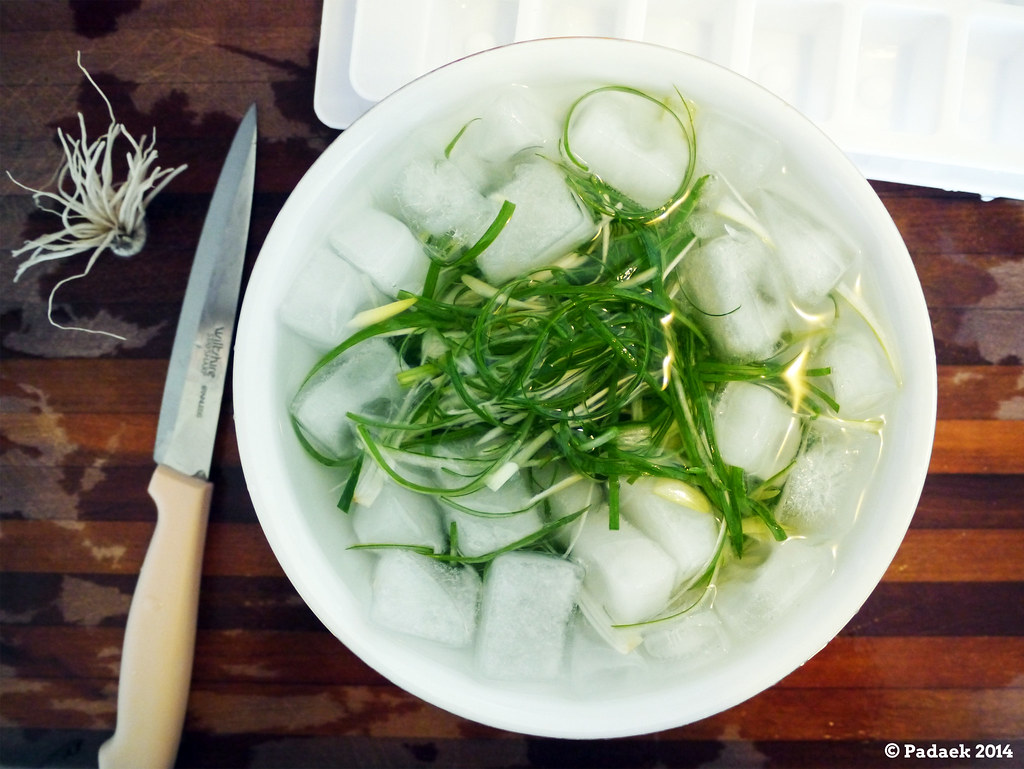
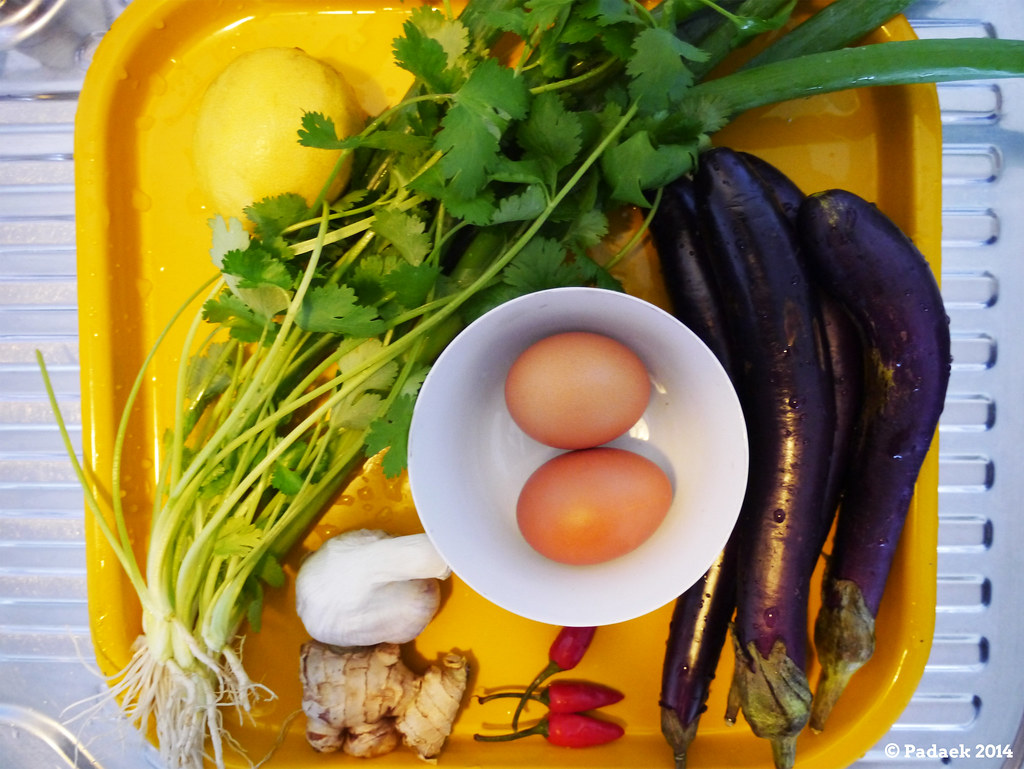
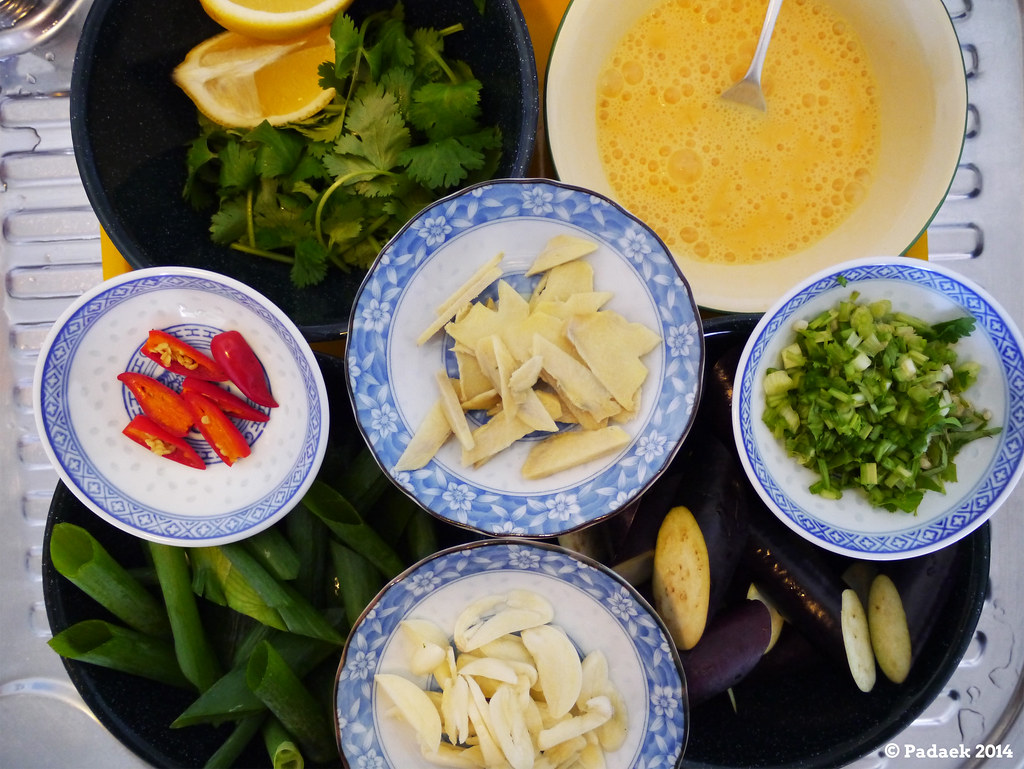
Meanwhile, prepare the other ingredients: wash and diagonally slice the eggplant into 5 cm pieces; wash and slice the chilies in half length-ways, peal, crush and slice the garlic cloves; wash, peal and slice the knob of ginger; wash, remove the roots and diagonally slice the spring onions into 5 cm pieces; wash and cut the coriander in half, separating the root/stems from the leaves – finely chop the root/stems and roughly chop the leaves (place the finely chopped roots/stems and the roughly chopped leaves in separate bowls); crack the eggs in a small bowl and whisk well; wash and quarter the lemon/lime. Put all these ingredients aside.

After about 1 hour, remove the crab from the freezer. Remove the string (if any) from the crab and wash thoroughly under running water. Clean the crab: turn the crab upside down, lift its tail flap up and carefully dismantle/remove the shell from the crab’s body (optional – wash and keep the shell for presentation); remove the gills (aka ‘dead man’s fingers’) and dirty innards, if any (optional – retain the yellow ‘crab mustard’ (liver) for flavour).
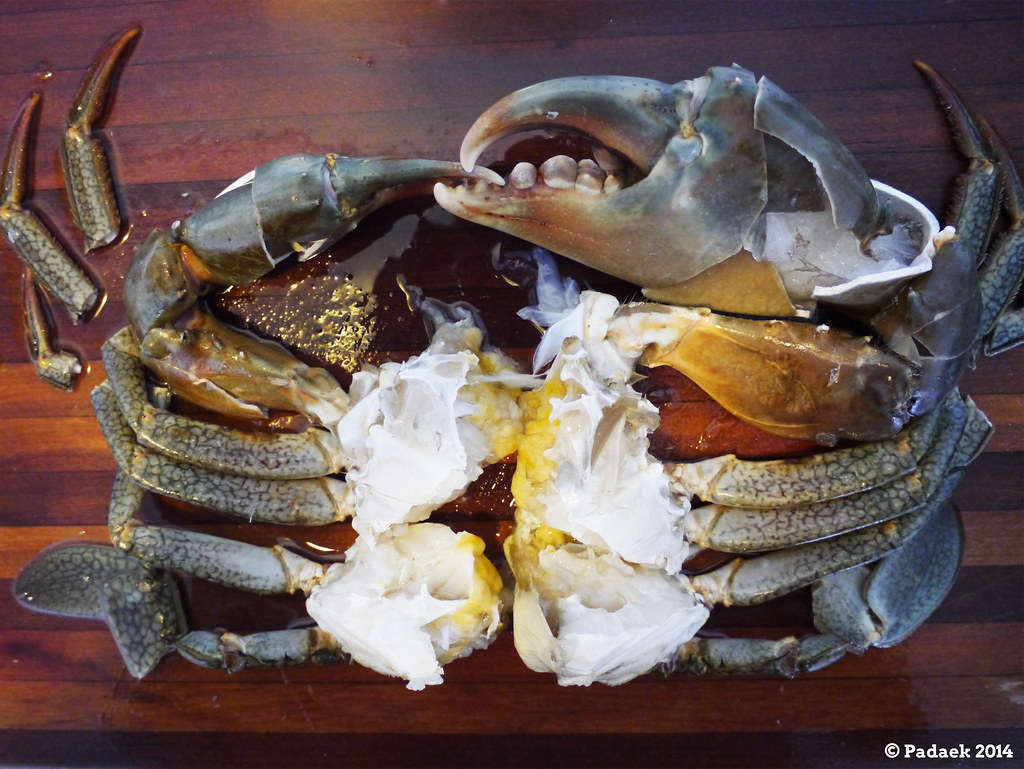
Gently wash the crab under running water again. Carefully break off the front claws/nippers from the body (optional – trim the body claw/leg tips). With a cleaver, cut the crab body into quarters. Crack open the front claws/legs with the back of a cleaver to allow the sauce to get in when cooking. Put the crab pieces aside.

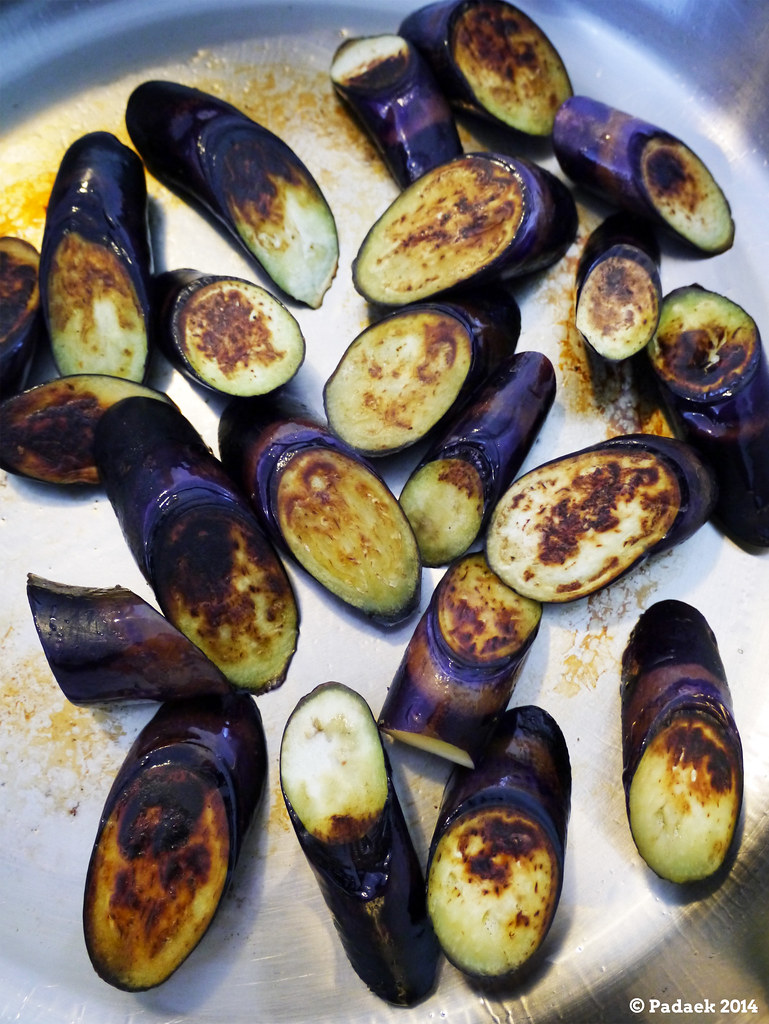
In a fry pan, heat 3 Tablespoons of cooking oil over medium heat and fry the sliced eggplant pieces on both sides until they turn golden brown. When they’re done, remove them from the pan and put aside.
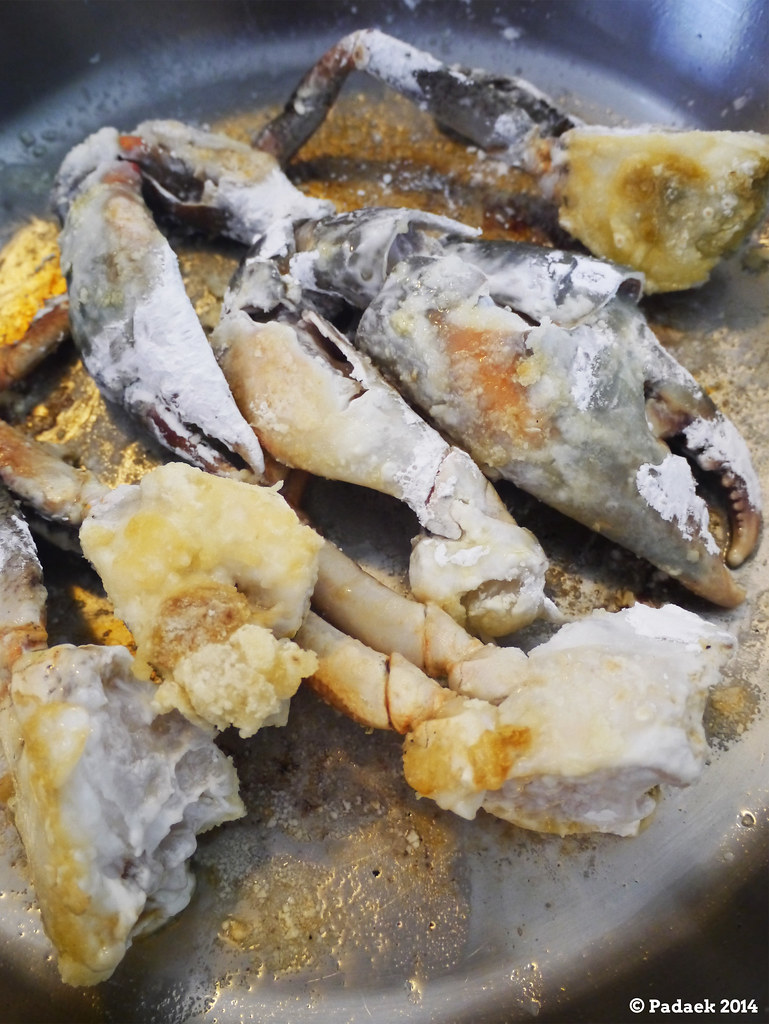
On a plate/shallow bowl – place the corn flour and lightly coat the crab pieces with the corn flour. In a fry pan, heat 3 Tablespoons of cooking oil over medium heat and and fry the coated crab pieces until the shell turns orange. When they’re done, remove them from the pan and put aside.
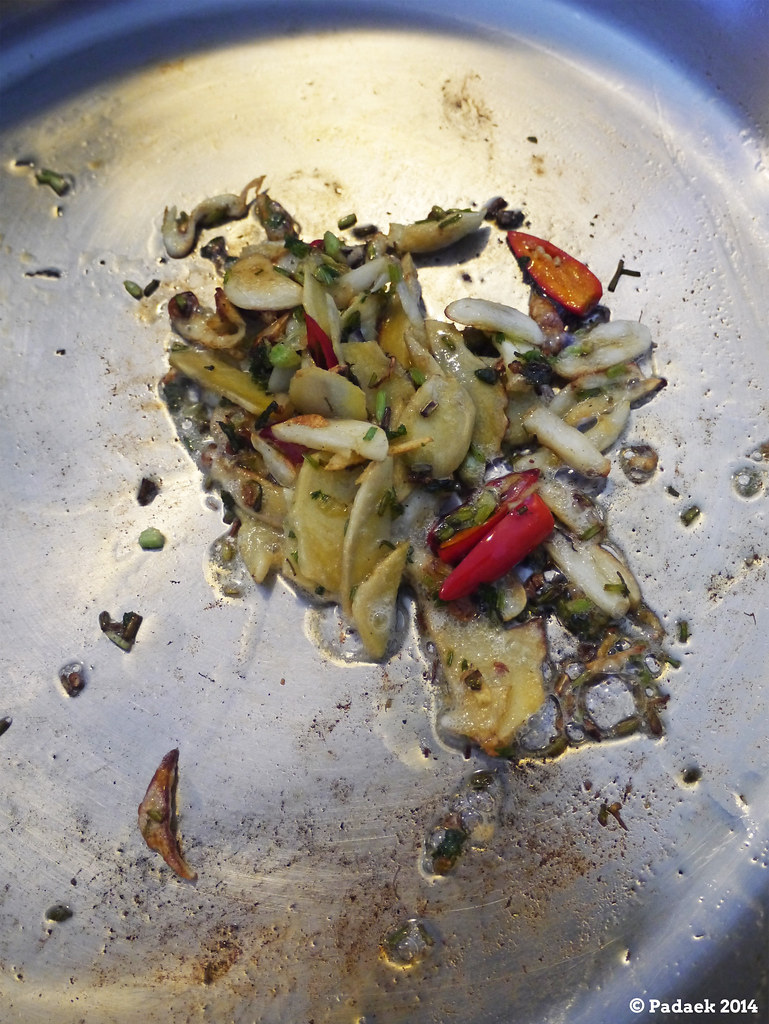
In a fry pan or wok, heat 3 Tablespoons of cooking oil over medium heat. Add the chili, garlic, ginger and coriander root/stems, and saute for about 1 minute, until they turn light brown.

Add the crab pieces and gently stir through for 1 minute. Pour the egg evenly over the crab pieces and quickly stir through, scrambling the egg. Add the fish sauce, soy sauce, oyster sauce, sugar, salt, and cracked black pepper, and stir through evenly.
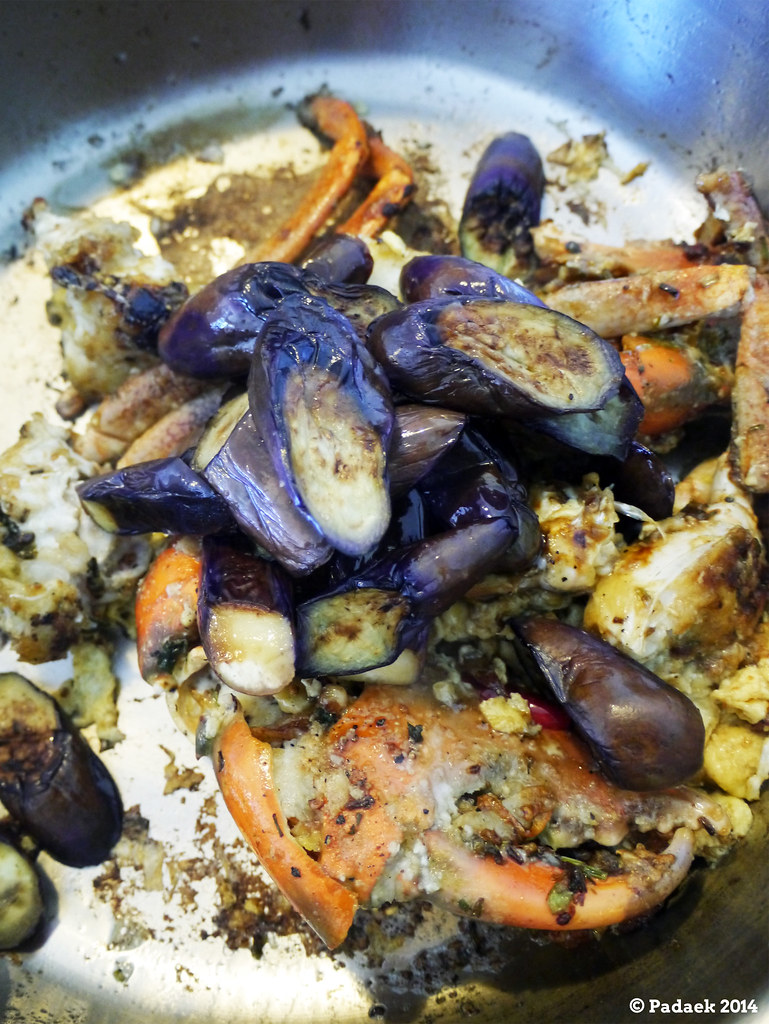
Add the fried eggplant pieces and gently stir through.

Add the sliced spring onions and coriander leaves (optional – you can reserve half of the coriander leaves for garnish) and stir through.
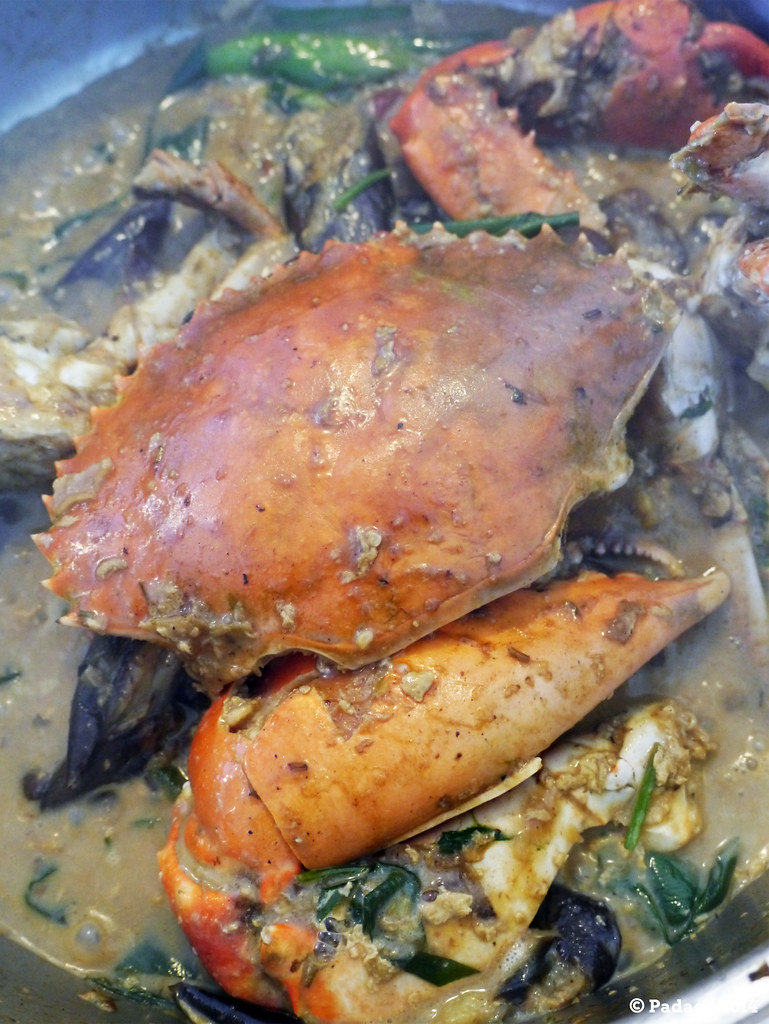
Add the water and wine, and gently stir through (optional – if you’ve decided to keep the shell for presentation, add it now and stir through to cook it also). Reduce the heat and let simmer for about 5 minutes, until the crab is cooked. The crab is cooked when the crab meat is white and firm, and the shell is vibrant orange. Stir through one more time and taste the sauce – adjust to suit your palate. What you’re aiming for is a deliciously balanced savoury, sweet, herbal and mildly spicy sauce.
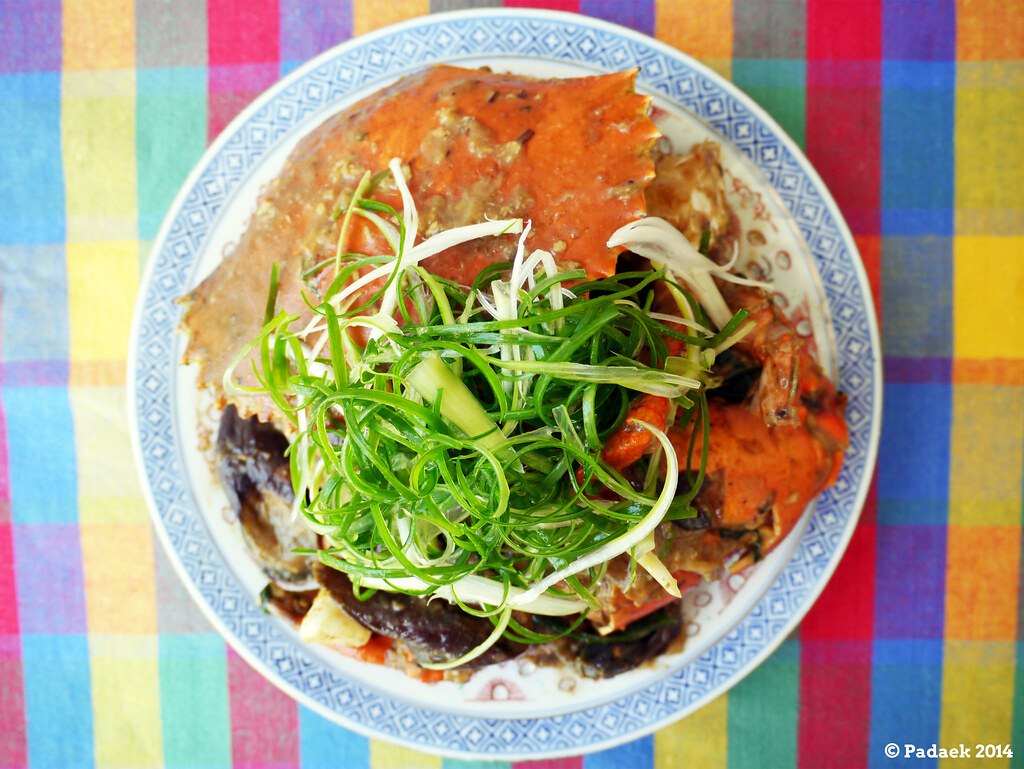
Transfer to a large serving plate or bowl, ensuring that the crab is served with the eggplant pieces, and generously coated in the delicious sauce. Garnish with chopped coriander leaves or curled spring onions.


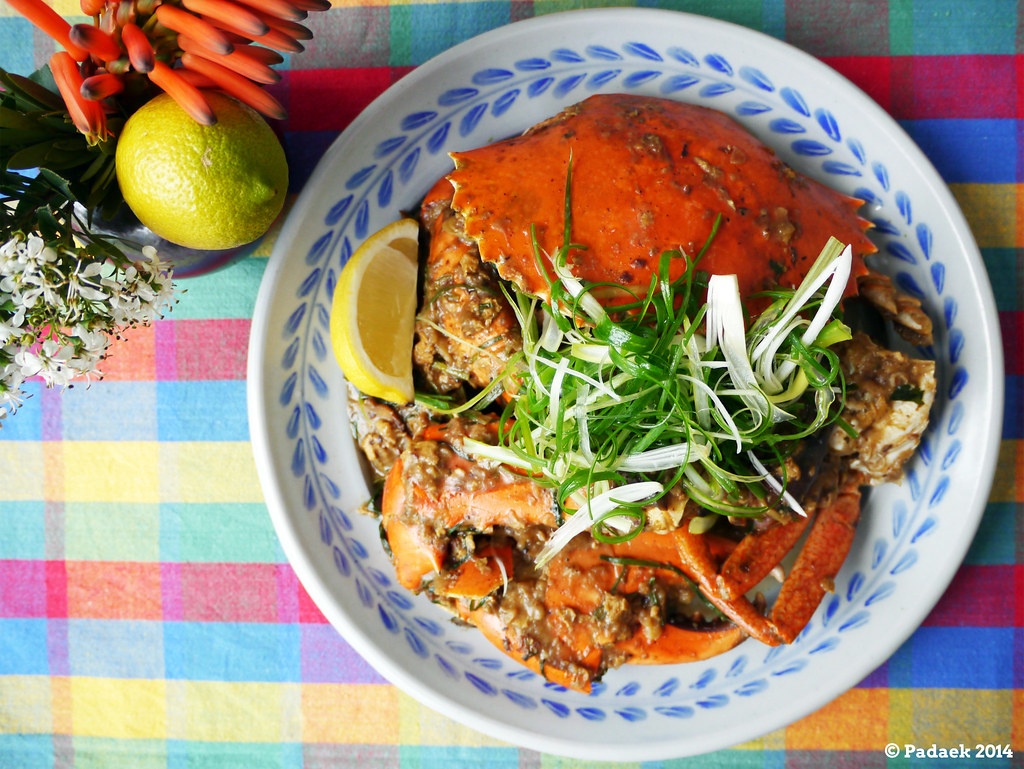
Serve with lemon/lime wedges, and carb of your choice – grilled bread, baguette, sourdough, steamed rice or sticky rice. This dish is messy to eat yet finger-licking delicious! Be sure to have finger bowls by your side. Enjoy your meal!smile
- 1 mud crab (1 kg)
- 4 long purple eggplants
- 3 bird's eye chilies
- 4 cloves of garlic
- 1 knob of ginger
- 3 spring onions
- 3 coriander
- 2 eggs
- 1 lemon/lime
- ½ Tablespoon of fish sauce
- ½ Tablespoon of light soy sauce
- 1 Tablespoon of oyster sauce
- ½ Tablespoon of sugar
- pinch of salt
- cracked black pepper
- ½ cup of cornflour
- 3 Tablespoons of cooking oil (for frying the eggplant)
- 3 Tablespoons of cooking oil (for frying the mud crab)
- 3 Tablespoons of cooking oil (for stir frying)
- 1 cup of water
- ½ cup of white wine
- Place the crab in the freezer for about 1 hour to put it to sleep.
- Meanwhile, prepare the other ingredients: wash and diagonally slice the eggplant into 5 cm pieces; wash and slice the chilies in half length-ways, peal, crush and slice the garlic cloves; wash, peal and slice the knob of ginger; wash, remove the roots and diagonally slice the spring onions into 5 cm pieces; wash and cut the coriander in half, separating the root/stems from the leaves - finely chop the root/stems and roughly chop the leaves (place the finely chopped roots/stems and the roughly chopped leaves in separate bowls); crack the eggs in a small bowl and whisk well; wash and quarter the lemon/lime. Put all these ingredients aside.
- After about 1 hour, remove the crab from the freezer. Remove the string (if any) from the crab and wash thoroughly under running water.
- Clean the crab: turn the crab upside down, lift its tail flap up and carefully dismantle/remove the shell from the crab's body (optional - wash and keep the shell for presentation); remove the gills (aka 'dead man's fingers') and dirty innards, if any (optional - retain the yellow 'crab mustard' (liver) for flavour).
- Gently wash the crab under running water again.
- Carefully break off the front claws/nippers from the body (optional - trim the body claw/leg tips). With a cleaver, cut the crab body into quarters. Crack open the front claws/legs with the back of a cleaver to allow the sauce to get in when cooking. Put the crab pieces aside.
- In a fry pan, heat 3 Tablespoons of cooking oil over medium heat and fry the sliced eggplant pieces on both sides until they turn golden brown. When they're done, remove them from the pan and put aside.
- On a plate/shallow bowl - place the corn flour and lightly coat the crab pieces with the corn flour.
- In a fry pan, heat 3 Tablespoons of cooking oil over medium heat and and fry the coated crab pieces until the shell turns orange. When they're done, remove them from the pan and put aside.
- In a fry pan or wok, heat 3 Tablespoons of cooking oil over medium heat. Add the chili, garlic, ginger and coriander root/stems, and saute for about 1 minute, until they turn light brown.
- Add the crab pieces and gently stir through for 1 minute.
- Pour the egg evenly over the crab pieces and quickly stir through, scrambling the egg.
- Add the fish sauce, soy sauce, oyster sauce, sugar, salt, and cracked black pepper, and stir through evenly.
- Add the fried eggplant pieces and gently stir through.
- Add the sliced spring onions and coriander leaves (optional - you can reserve half of the coriander leaves for garnish) and stir through.
- Add the water and wine, and gently stir through (optional - if you've decided to keep the shell for presentation, add it now and stir through to cook it also). Reduce the heat and let simmer for about 5 minutes, until the crab is cooked. The crab is cooked when the crab meat is white and firm, and the shell is vibrant orange.
- Stir through one more time and taste the sauce - adjust to suit your palate. What you're aiming for is a deliciously balanced savoury, sweet, herbal and mildly spicy sauce.
- Transfer to a large serving plate or bowl, ensuring that the crab is served with the eggplant pieces, and generously coated in the delicious sauce.
- Garnish with chopped coriander leaves or curled spring onions (instructions in the photos above).
- Serve with lemon/lime wedges, and carb of your choice - grilled bread, baguette, sourdough, steamed rice or sticky rice.
- This dish is messy to eat yet finger-licking delicious! Be sure to have finger bowls by your side. Enjoy your meal!smile
Did you know?
- As all crabs grow, they shed their shells from time to time. Once they’ve moulted, they have a period of about 2 hours when their new shell is developing and hardening, and they are edible shell-and-all. ‘Soft shell crabs’ are not a particular species of crab, but rather, any crab that has moulted. In Australia, high-tech aquaculture has begun, whereby blue swimmer and mud crabs are being carefully monitored by robotics that detect when they have just moulted. The crabs are then removed from the water which stops the ‘recalcification’ of their shells.((4))
[[1]]Mud crabs are common and endemic to most of the Australian coastline from NSW north around to Shark Bay, WA. Most of the commercial catch is from Queensland and NT, with some also from NSW. Mud crabs are caught in pots, drop nets and dillies. They are available year round with peaks from January to April in Queensland and NSW, and from May to August in NT. Reference: http://www.sydneyfishmarket.com.au/Information/SpeciesInfo/tabid/91/xmmid/620/xmid/195/Default.aspx.[[1]]
[[2]]When cooking mud crab (or any crab for that matter) – it is best to do so immediately, after the crab had been purchased/caught and sent to lala-land by freezing it.[[2]]
[[3]]I’m not sure what variety these eggplants are exactly, but I researched online, and believe that they’re also called Oriental eggplant (Asian eggplant), Chinese eggplant, Japanese eggplant, Lebanese eggplant, ‘Ping Tung’, etc. Reference: http://www.evergreenseeds.com/oreg.html.[[3]]
[[4]]Reference: http://www.sydneyfishmarket.com.au/FISHline/SpeciesInfo/Crab/tabid/167/Default.aspx.[[4]]

You taught me a lot about crabs, especially the shell shedding :). I love your recipe! Will make this for lunch, thanks!
Julie
Gourmet Getaways
Hi Julie,
Thank you – glad you like the post and the recipe. The sweetness of crab meat and long purple eggplants pair really well here. Love eating crabs – although, it can be very messy and somewhat dangerous. A wonderful lunch awaits you. Have a great day! :)
Dear Padaek,
I prefer the long thin eggplants for Asian stir-fries. It’s an excellent choice for this beautiful dish as it soaks up all the flavoursome sauce like a sponge.
Hi ChopinandMysaucepan,
Thank you for your comment. Yes, the Asian long eggplants worked wonderfully for this dish and blended and soaked up the sauce with great results. Some people dislike eggplant for its sponginess, but I love it and their versatility too. Best wishes! :)
wow that looks lip smackingly delicious! ive always wanted to cook crabs but have never been game enough!
Hi chocolatesuze,
Thank you – yes, there was not much complaints with this dish, although eating crab can be very messy (yet fun) and sometimes bad for the teeth too. Cooking mud crab (or any crabs) is really easy – the only difficult part if prepping the ingredients and the crab. Once the crab is asleep, there’s nothing to be afraid of. :)
Thank you for the crab preparation tips, that’s really helpful when I’ve never cooked crab in this way before. Looks delicious. I agree with your interest in eggplants. Thai eggplants are awesome and are very easy to grow.
Hi Jem,
Thank you for your comment. Preparing/cleaning the mud crab is pretty easy to do with some experience and especially when the crab is asleep.Yep, love eggplant and its versatility. Mum grows the Thai eggplants and I love eating them fresh as a side or prepared similar to spicy green papaya salad. They often have a lot of seeds and I like their texture and flavour – very pretty looking too. :)
yum I love crab! For some reasons though, I’ve always been scared of cooking one… Probably because when my mum did put a live on in the pot, I would always be scared it would jump out!
Hi Mademoiselle Mange à Sydney,
Crabs are a great treat and a lot of fun to eat, and cooking them doesn’t have to be difficult. I understand what you mean by cooking live crabs, etc especially with their scary pincers waving – lol. By putting them to sleep first, you don’t have to deal with this problem. It should only take about 30 mins or so. Hope you give cooking crabs a go. :)